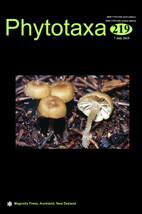Abstract
A phylogenetic study testing the monophyly of the geographically disjunct genus Ronnbergia (Bromeliaceae, Bromelioideae) is presented. The phylogenetic analyses were based on taxon sampling that included all but one species of Ronnbergia, and representative lineages across the subfamily Bromelioideae. Three chloroplast DNA sequence markers (matK, psbA-trnH, and trnL-trnF) and morphological data were used for the phylogenetic reconstruction. Both the molecular and morphological datasets supported the polyphyly of Ronnbergia, either independently or in combination. These findings suggest that the geographic disjunction of this genus is most likely a product of taxonomic misinterpretation. The results also indicate that the species currently circumscribed in Ronnbergia are closely related to species in the genus Aechmea with similar geographic ranges. The datasets do not have enough resolution power to reconstruct a deep phylogenetic history that involves all the species of Ronnbergia. Nevertheless, this study provides clues for future approaches that should focus on a larger species sampling and the use of multi-locus DNA sequence data.

